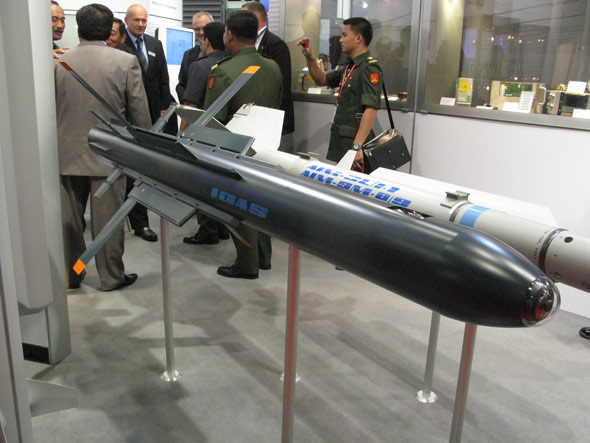Diehl Defense from Germany is back at the Singapore Airshow promoting a number of defense systems which are of high value to customers in Asia. Particularly interesting is the IDAS (Interactive Defence and Attack System for Submarines). This unique submarine launched anti-helicopter weapon is designed to protect attack submarines from anti-submarine helicopters, as they become vulnerable hovering low above water, dipping their sonar in search of enemy submarines. This subsonic missile is optimized to seek out such slow targets, which pose significant risk to a submarine operating at littoral, ‘brown’ waters.
Four missiles will be stored in a magazine that fits into a standard 21″ torpedo tube. The missiles are ejected from the magazine into the water, extract their wings and separate quietly from the submarine, where they ignite the rocket and transition to airborne flight, propelled by the weapon’s rocket motor.
One of the development challenges was the propulsion system. The same rocket was required to provide thrust for both underwater and airborne flight. The rocket was designed to sustain the missile’s at optimal velocity in submerged flight, and accelerate to subsonic flight while airborne, reaching effective range of 20 km. Another concern was sustaining the optical-fiber through the transit below and above water. Diehl’s engineers were concerned how the fiberoptic bobbins will behave in the different environments (below and above water) the test provided clear evidence this will not be an issue.
Diehl initially considered using the IRST seeker for IDAS, however, this high performance and all aspect seeker may not be the only option, and other seekers might be considered to pick up the target, provided with passive cuing from by the submarine sonar. The submarine can acquire ASW helicopter when submerged, by localizing the ripple effect created by the rotor downwash. According to Diehl, the accuracy of such cuing system is adequate to provide bearing and range, bringing the missile seeker to autonomously acquire the target with high level of confidence. The fiber optical link would then be used by the crew to verify the target, confirm the intercept and perform battle damage assessment.
IDAS was originally developed for the German Type 212 submarines but the program has since frozen due to German defense budget cuts. Originally the missile was planned to become operational in 2014 but this timetable is now unlikely as the German Navy acquisition programs have stalled recently due to lack of funding. Diehl is currently talking to international partners seeking bridging funding for the program, to sustain the development through the next stage.In few years, Diehl is confident the high interest in the program will turn into formal endorsement by foreign navies that have already expressed much interest in the program.
For the missile development Diehl has teamed with Submarine builder HDW, which is now part of the Thyssen-Krupp Marine Systems (TKMS). Originally the weapon was designed to be integrated in the HDW Type 212 submarine but, according to Diehl, it can be integrated with other HDW types.
IDAS is formally still in the proof of concept phase, which culminated four years ago in a submarine launch performed by the German Navy U33 Type 212 submarine in 2008. This test examined the underwater launch system, with the missile ejected from the torpedo tube, igniting the rocket under water, separating from the submarine without leaving significant signature (avoiding exposure of the submarine location). Following this maneuver IDAS performed a course change under the water, streaking vertically into the air. Back in 2008 the test focused on this transition phase, with future tests, to be performed when funding is available, would continue with full flight, target acquisition, guidance and battle damage assessment.



















